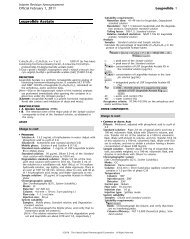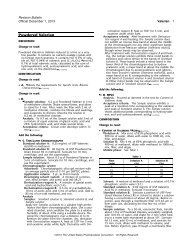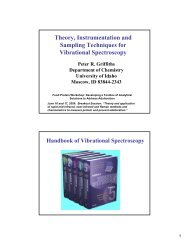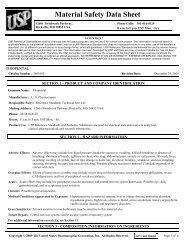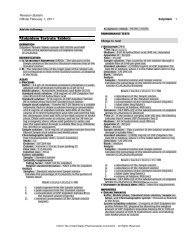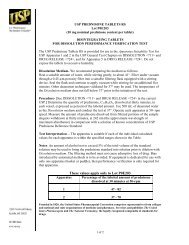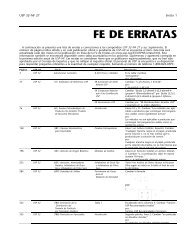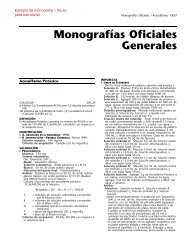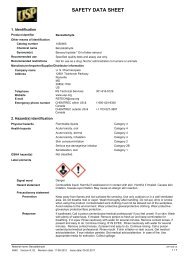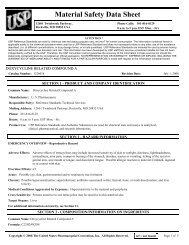rptEntry Form Print - US Pharmacopeial Convention
rptEntry Form Print - US Pharmacopeial Convention
rptEntry Form Print - US Pharmacopeial Convention
You also want an ePaper? Increase the reach of your titles
YUMPU automatically turns print PDFs into web optimized ePapers that Google loves.
LEVAMISOLE HYDROCHLORIDE<br />
Catalog Number: 1359302 Revision Date: March 16, 2011<br />
Storage: Store in tight container as defined in the <strong>US</strong>P-NF. This material should be handled and stored per label instructions to ensure<br />
product integrity.<br />
SECTION 8 - EXPOSURE CONTROL / PERSONAL PROTECTION<br />
Engineering Controls: Airborne exposure should be controlled primarily by engineering controls such as general dilution ventilation,<br />
local exhaust ventilation, or process enclosure. Local exhaust ventilation is generally preferred to general<br />
exhaust because it can control the contaminant at its source, preventing dispersion into the work area. An<br />
industrial hygiene survey involving air monitoring may be used to determine the effectiveness of engineering<br />
controls. Effectiveness of engineering controls intended for use with highly potent materials should be assessed<br />
by use of nontoxic surrogate materials.<br />
Local exhaust ventilation such as a laboratory fume hood or other vented enclosure is recommended,<br />
particularly for grinding, crushing, weighing, or other dust-generating procedures.<br />
Respiratory Protection: Where respirators are deemed necessary to reduce or control occupational exposures, use NIOSH-approved<br />
respiratory protection and have an effective respirator program in place (applicable U.S. regulation OSHA 29<br />
CFR 1910.134).<br />
Gloves: Chemically compatible. For handling solutions, ensure that the glove material is protective against the solvent being used. Use<br />
handling practices that minimize direct hand contact. Employees who are sensitive to natural rubber (latex) should use nitrile<br />
or other synthetic nonlatex gloves. Use of powdered latex gloves should be avoided due to the risk of latex allergy.<br />
Eye Protection: Safety glasses with sideshields are recommended. Face shields or goggles may be required if splash potential exists or<br />
if corrosive materials are present. Approved eye protection (e.g., bearing the ANSI Z87 or CSA stamp) is preferred.<br />
Maintain eyewash facilities in the work area.<br />
Protective Clothing: For handling of laboratory scale quantities, a cloth lab coat is recommended. Where significant quantities are<br />
handled, work clothing may be necessary to prevent take-home contamination.<br />
Exposure Limits: n/f<br />
SECTION 9 - PHYSICAL AND CHEMICAL PROPERTIES<br />
Properties as indicated on the MSDS are general and not necessarily specific to the <strong>US</strong>P Reference Standard Lot provided.<br />
Appearance and Odor: White or almost white crystalline powder.<br />
Odor Threshold: n/f<br />
Melting Range: 224 - 231° C<br />
Boiling Point: n/f<br />
Evaporation Rate: n/f<br />
Vapor Pressure: n/f<br />
Vapor Density: n/f<br />
Specific Gravity: n/f<br />
associated with the material. Clean equipment and work surfaces with suitable detergent or solvent after use. After removing<br />
gloves, wash hands and other exposed skin thoroughly.<br />
pH: 3.0 to 4.5 (5% solution)<br />
Flash Point: n/f<br />
Autoignition Temperature: 570° C<br />
Upper Flammability Limit: n/f<br />
Lower Flammability Limit: n/f<br />
Solubility in Water: Freely soluble<br />
Fat Solubility:




